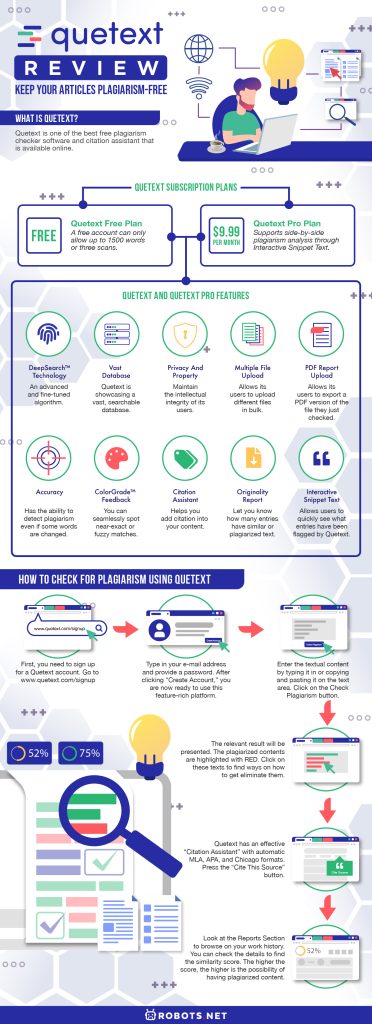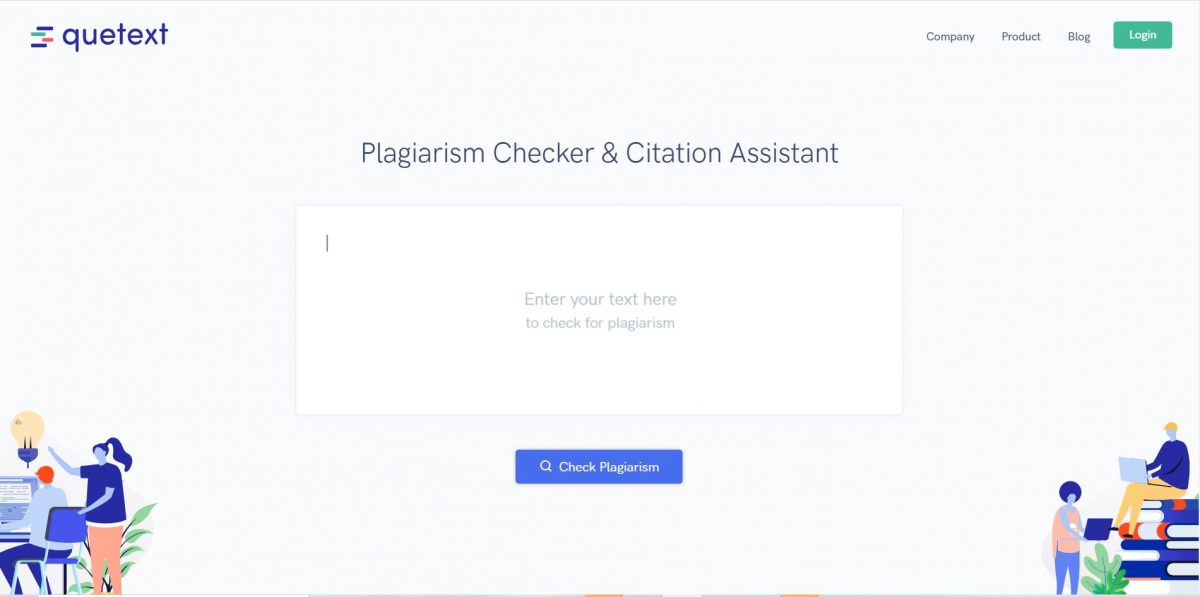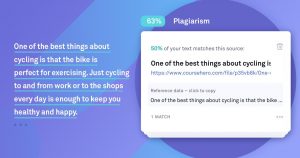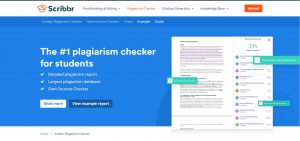Plagiarism is a big issue that greatly affects academic and research circles. In writing, authors and writers convey their thought, ideas, and expressions. However, some used to copy some lines from other people’s articles though some are doing it unintentionally. Although we want good feedback for our content, we should not plagiarize. It is not about the writing ethics but to show our respect to other authors and writers. With that, we need to check our writings using plagiarism checkers. Since the internet has offered us a lot of plagiarism checkers to use, we can grab this opportunity and use or more of these available checkers.
One of these plagiarism checkers that is commonly used by students and writers is the Quetext Plagiarism Checker. This will help us know if the contents of our works have common lines with other authors to ensure that we are not presenting information initially provided by others as our own.
In this article, we will discuss what Quetext is, how to create a Quetext account, and its features. Moreover, we will tackle how to use this plagiarism checker and its reliability. We will also talk about its pros and cons and some of its competitors.
What is Quetext?
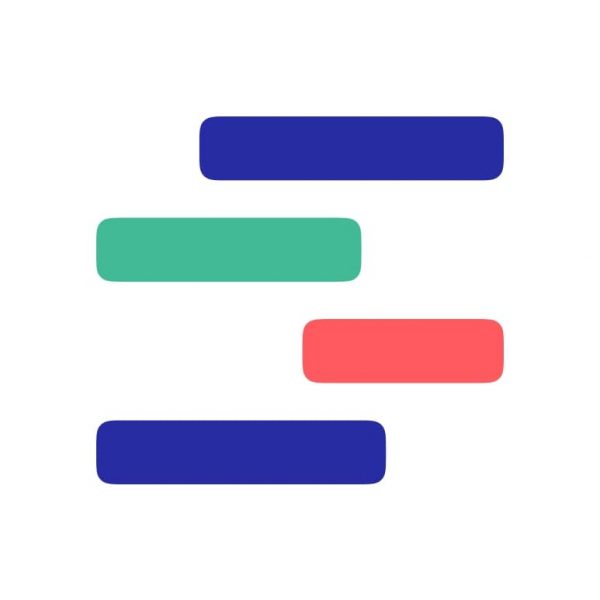

Quetext is one of the best free plagiarism checker software and citation assistant that is available online. With its advanced DeepSearch™ technology, it offers a distinctive approach to detect copied content and check your writings for signs of incidental plagiarism. This is a big help to writers, bloggers, students, and academics to make sure their works are free of plagiarism.
It features one of the largest databases of searchable books, web pages, and journals, making it an essential tool for any blogger, freelance writer, student, or academic.
Quetext does not only find matched phrases but also detects duplicate text even when the words get twisted.
If you want to see how Quetext stacks up to its competition, check our review of SmallSEOTools.
How to Create a Quetext Account?
- Go to quetext.com/signup.
- Enter your e-mail address by typing it then create a password.
- Click on “Create Account.”
- You can now use Quetext.
Quetext Subscription Plans
Quetext is available in two subscription plans. You can have the Free Plan or the Pro Plan.
Quetext Free Plan
Experience the power of Quetext with its free plan. Its free subscription service will allow you to scan up to 500 words for any problematic matches. It offers ColorGrade™ Feedback, which helps to easily notice and remove plagiarism. Also, it looks after simple words through its Contextual Analysis and able to detect any attempt to conceal plagiarism via Fuzzy Matching.
Unfortunately, a free account can only allow up to 1500 words or three scans, paltry numbers compared to the volume that writers and academics have to churn out all the time. Also, you need to copy-paste the content you need scanned since it doesn’t support uploading of documents. Additionally, your content scans will not use DeepSearch™ technology. With that, you can’t be sure that the scan results are reliable.
Quetext Pro Plan
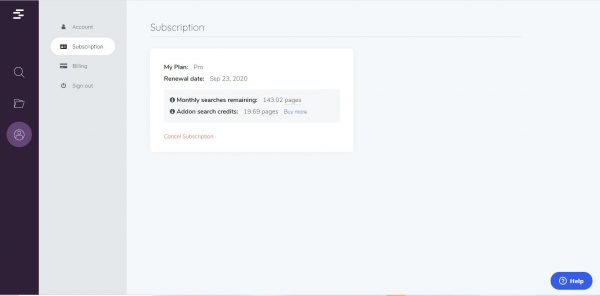

For more advanced plagiarism checking, you can upgrade to Quetext Pro by paying $9.99 per month. Featuring DeepSearch™ and Citation Assistant with APA, MLA, and Chicago formats, this is the way to go. Quetext Pro provides a URL and Domain Exclusion Tool to give you a better searching experience. It also supports side-by-side plagiarism analysis through Interactive Snippet Text.
In addition to this, you can scan your documents of up to 25, 000 words. Also, you can download the PDF report of your scanned document with highlighted content which Quetext believes the author copied or plagiarized. Furthermore, you can upload multiple files simultaneously to check instant results.
Quetext and Quetext Pro Features
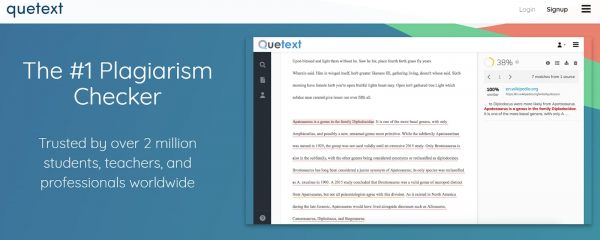

DeepSearch™ Technology Using Contextual Analysis and Conditional Scoring
Quetext’s DeepSearch™ Technology is an advanced and fine-tuned algorithm. It takes the process of checking plagiarism into a different and deeper level by searching through the internet and other sources.
DeepSearch uses contextual plagiarism rather than the normal phrase match process so rest assured that they have high quality checks. This is to detect the possibility of copied content material and differs from what other plagiarism checker tools use. Furthermore, DeepSearch matches the provided phrase in the context of nearby phrases, words, and sentences within the paragraph to check if they are plagiarized or not.
This does not limit to word or phrase matching only. It goes deeper into the content of the text and analyzes the context as the next sentence. With that, if the sentence next to the phrase is the same to the sentence next to the phrase in the original phrase, the neighboring sentence will not be the only one identified as plagiarized but also the first sentence.
Vast Database to Match Similarity
Quetext is showcasing a vast, searchable database consisting of more than 35 billion web pages, 20 million books, and one million academic journals making scanning for any evidence of duplicate or plagiarized content as efficient and reliable as possible.
Quetext’s vast database is relatively bigger than what most free plagiarism checkers have.
Privacy and Property
Quetext aims to maintain the intellectual integrity of its users by ensuring that they are not saved anywhere else. They believe that users should have the right to their output, so they took steps to ensure that it does not save the users’ uploaded documents to its database after they used it.
Users should also take note that Quetext does not claim any of your documents or works upon checking.
Multiple File Upload
Quetext also allows its users to upload different files in bulk. You can upload five documents simultaneously to check results on the internet and from its database immediately. Moreover, it supports file formats like PDF, MS Word, and pages and plain-text contents.
PDF Report Upload
Quetext also allows its users to export a PDF version of the file they just checked. The Pro version allows you to keep all reports of files that you have checked for plagiarism. The PDF reports can be downloaded to be used however you see fit.
Exclude Sources
This is not available to users that use the free account. However, for premium users, this tool is useful if they want to exclude or reject sources that they don’t like to show up in results. The content will not be compared to those from the excluded sources for proofs of duplicate content. Moreover, they can use this tool if they want to know if someone has copied and pasted their content on another website.
Accuracy
Quetext has the ability to detect plagiarism even if some words are changed or the contents get twisted.
ColorGrade™ Feedback
With this feature, you can seamlessly spot near-exact or fuzzy matches with corresponding colors. With that, you can easily take appropriate actions and engage with your results.
Rich and Intuitive
Find plagiarism easily with just a click of a button.
Citation Assistant
This built-in citation feature assists in checking plagiarism and helps you add citation into your content if there are paragraphs that are plagiarized.
Originality Report
If you want to see a percentage score of how much of your gets flagged for plagiarism, Quetext will provide you with a percentage score. It’ll also let you know how many entries have similar or plagiarized text.
Interactive Snippet Text
This allows users to quickly see what entries have been flagged by Quetext. Very helpful if you want to rewrite a specific portion of your article.
How To Check for Plagiarism Using Quetext
- First, you need to sign up for a Quetext account. Go to www.quetext.com/signup to create a free account.
- Type in your e-mail address and provide a password. After clicking “Create Account,” you are now ready to use this feature-rich platform.
- Enter the textual content by typing it in or copying and pasting it on the text area. Click on the Check Plagiarism button on the bottom part of the screen.
- With Quetext’s speed in recognizing plagiarism, the relevant result will be presented in front of you within a few seconds depending on the amount of text scanned The plagiarized contents are highlighted with RED. Click on these texts to find the sources of the original content and find ways on how to get eliminate them.
- Quetext has an effective “Citation Assistant” with automatic MLA, APA, and Chicago formats. Press the “Cite This Source” button. You will be redirected to a form where need to enter the source details, which include the name of the author, publisher, publication title, and the date of publication. After inputting all the necessary details, click on the “Create Citation” button. You will be given three different formats to choose from to be used in your writing. These can be APA, MLA, or Chicago format.
- You can take a look at the Reports Section to browse on your work history. You can check the details to find the similarity score. Take note that the higher the score, the higher is the possibility of having plagiarized content.
Is Quetext Reliable?
Consisting of a highly dedicated development team with industry-leading developers of plagiarism detection technology that has their own quality-assurance processes, Quetext makes sure that it focuses on accuracy and makes that every update and release of its product is strictly evaluated. Furthermore, you can be sure that the data that you submitted on its site is safe because it doesn’t save all the data on its database. Also, it doesn’t claim the ownership of the content that you checked for plagiarism. In addition to this, it ensures the integrity of your content and makes sure that you will be keep updated with any possible necessary citation opportunity.
Pros and Cons of Quetext
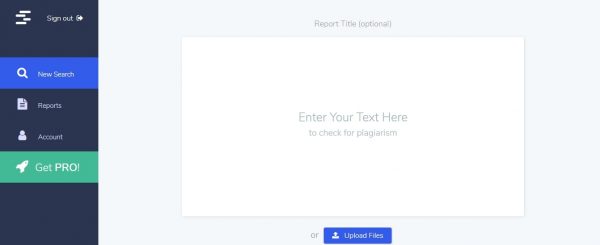

Pros
- Uses DeepSearch™ technology
- Accurate
- Respects users’ privacy
- Keeps its integrity
- Easy to sign up using a Google account
- Upload multiple files
- Access to Reports Section
- URL exclusion
- Multiple languages
- Detailed reporting exporting
- Built-in citation
- Smooth hands-on test
- Doesn’t require to download any software to use the platform
Cons
- Insufficient site consistency
- A need for a paid subscription to scan more than 500 words
- No annual plan
- Can’t export reports on the free plan
- Doesn’t check plagiarism on scholarly articles
- False positives
- Restricted word counts
- No grammar checkers
- No mobile apps
- Only copy and paste uploads on the free plan
Quetext Alternatives
SmallSeoTools
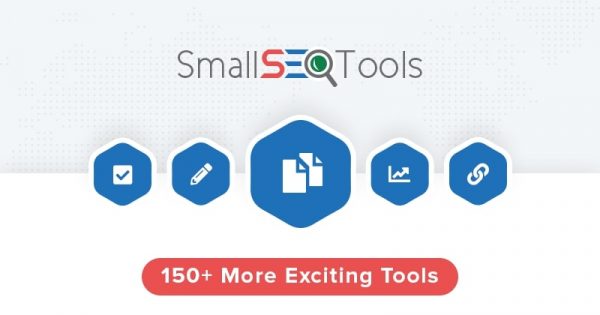

This provides a very basic but reliable plagiarism checker. It is primarily meant for people who mean to check short content to scan for plagiarism. This site is popular among students, bloggers, writers, and freelancers.
This plagiarism checker is free and easy to use. However, you can find a lot of distracting buttons and advertisements when using it. You can only scan 1,000 words, and the plagiarized contents are not highlighted in the document.
Duplichecker
This is one of the best plagiarism checkers available. It is easy to use, and you can choose between copying and pasting your document to be checked or just upload your document from your computer. Moreover, it offers not only plagiarism check but also word counter, keyword position, paraphrasing tool, and many others. However, you can only scan once a day without a free account that allows up to fifty scans.
Scribblr
This is the best plagiarism checker available. It has large access to scholarly databases and is really successful at detecting plagiarism. Moreover, it can efficiently find more similarities than what other plagiarism checkers can do. In addition to this, it provides a plagiarism report that includes the percentage of plagiarism and a list of sources that have similarities with your content. It also offers proofreading and editing services.
Be Confident with Your Document with Quetext
When writing a document, we have to make sure that it is free from plagiarism. Intended or not, plagiarism can lead us to be sanctioned. Even though we may not be that affected, we need to be careful and be honest in writing. With that, we need to check our documents using the available plagiarism checker like Quetext. You can rely on this checker since it uses DeepSearch™ technology. Also, it offers a lot of features that will help us to have a plagiarized free document. When you use it, you’ll be confident to claim that your document is original, and all the ideas in the content are all yours.
If you’re looking for more tools to help you in writing an article or study, why not check out our list of the best free alternatives to Grammarly.
